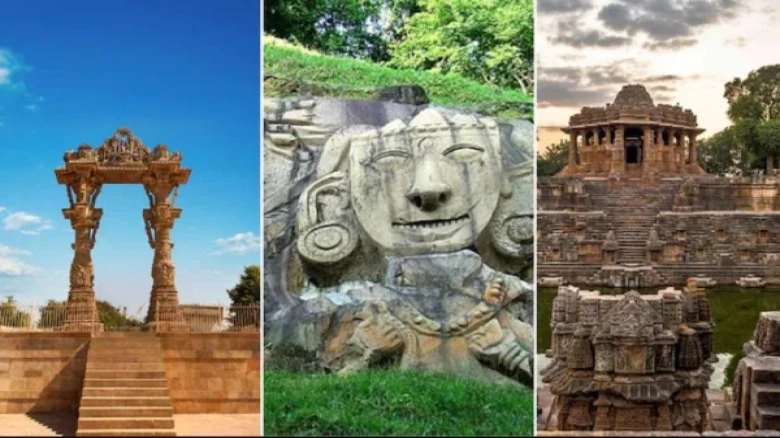Regional

The Archaeological Survey of India (ASI) remarked that the move will benefit India's cultural heritage immensely...
Digital Desk: Three heritage sites from India were recently added to the tentative list of UNESCO World History Sites, which can be considered a significant boost to India's rich cultural heritage.
In addition to the rock-cut sculptures of Unakoti in Tripura, two Gujarat cultural sites, the Sun Temples of Modhera and Vadnagar, have been included on the list.
Union Culture Minister G Kishan Reddy tweeted about the news, saying, “Congratulations India! India adds 3 more sites to @UNESCO’s Tentative List: Vadnagar- A multi-layered historic town, Gujarat, Sun Temple, Modhera and its adjoining monuments, Rock-cut Sculptures, and Reliefs of the Unakoti, Unakoti Range, Unakoti District.”
According to the Archaeological Survey of India (ASI), the decision will benefit India's cultural heritage massively.
The tentative list, for the uninitiated, is an inventory of the properties that each state party wants to evaluate for nomination. "States Parties are urged to submit their Tentative Lists, properties that they deem to be cultural and/or natural treasures of exceptional universal importance and hence suitable for inclusion on the World Heritage List," according to the UNESCO website.
Know What's inside Modhera’s Sun Temple-
The Sun Temple of Modhera, built-in 1026-27 CE under the reign of Bhima I of the Chaulukya dynasty, is set along the background of River Pushpavati and is encircled by a terra-formed garden of flowering trees. "The remains of the Sun Temples at Modhera devoted to Sun deity are vestiges of a bygone era when reverence for the natural elements fire, air, earth, water, and the sky was at their zenith, sharing space with innumerable forms of Vedic gods," according to the Gujarat Tourism website.
As you enter this ancient site, you will first notice the magnificent Kund named Ramakund. It is rectangular and comprises 108 shrines dedicated to various gods and demi-goals. The three principal shrines, dedicated to Ganesh, Vishnu, and Shiva, are located on the three sides of the kund.

"Ascend the steps to the 'Sabha Mandap,' or assembly, and gather with sculpted renditions of twelve 'Adityas' (another name for the sun god). "The twelve carved images on the pillars represent the sun according to the twelve months," according to the website.
After taking in the splendour of the 'Sabha Mandap,' one can go to the Garbhagruha. "The sun god's statue no longer exists, and the Suryavanshi Solankis have been scattered into the dust of history for a thousand years, but on the day of the Equinox, one can almost hear the chanting of prayers, the aroma of incense, the tinkling of bells as the sun's sharp, linear rays illuminate the inner core of life and light."
Know for what Vadnagar is fumely Famous?
Vadnagar, located in the Mehsana district, is an ancient heritage city with notable attractions such as Kiriti Toran, Hatkeshwar Temple, and Buddhist Monastery. According to the official Gujarat Tourism website, this city is described as "a prosperous and flourishing town" in the Puranas and even in the itinerary of the great Chinese explorer, Hieu-en-Tsang (7th century).
According to the inscription on the Arjun Bari Gate, King Kumarpal fortified the city in 1152 AD. Vadnagar has also been known as Chamatkarpur, Anandpur, Snehpur, and Vimalpur throughout history.

"You can feel 4500 years of history buried in the pottery fragments, fabrics, jewellery, and tools left behind by the agricultural populations who had established here" in this city.
Vadnagar was home to Dayaram and Narsinh Mehta, two of Gujarat's greatest poets, as do prominent authors like Govardhanram Tripathi, musicians like Kaumudi Munshi, and a slew of other artists and performers also resided in the city. Tana Riri Music Festival is held here to honour Nagar Brahmin sisters Tana and Riri. The Tana and Riri Samadhi, located south of town, honours their bravery.
What does the rock-cut sculptures of Unakoti in Tripura mean?
Unakoti means "one less than a crore," and it is stated that several rock cut carvings may be found here. According to Hindu legend, Lord Shiva stopped here during the night on his way to Kashi with one crore gods and goddesses. He summoned all the gods and goddesses to rise before the sun and travel to Kashi.
According to Unakoti Heritage website, It is a 'Shaiba' (Saivite) pilgrimage that dates back to the seventh to ninth centuries, if not earlier. The magnificent rock carvings, murals with their primal beauty, and waterfalls should not be skipped.

Story Behind-
It is stated that no one else could get up in the morning save Shiva, therefore Lord Shiva set out for Kashi solo, cursing the others to become stone figures.
As a result, Unakoti has less than a crore stone figures and engravings. These carvings are set in a beautifully planted woodland environment with lush green foliage all around, adding to their attractiveness. Unakoti's images are divided into two categories: rock-carved figures and stone images.
As per the Heritage site, The centre Shiva head and massive Ganesha sculptures stand out among the rock cut embellishments. The central Shiva head, known as 'Unakotiswara Kal Bhairava,' stands over 30 feet tall, including a 10-foot-high embroidered headdress. On each side of the central Shiva's headdress, there are two full-size female figurines, one of Durga standing on a lion and another on the opposite side.
In addition, three massive representations of Nandi Bull have been discovered partially buried in the ground. Unakoti also has a number of additional stone and rock cut images. Every year in April, a large fair known as the 'Ashokastami Mela' is conducted, which attracts thousands of pilgrims.
Leave A Comment